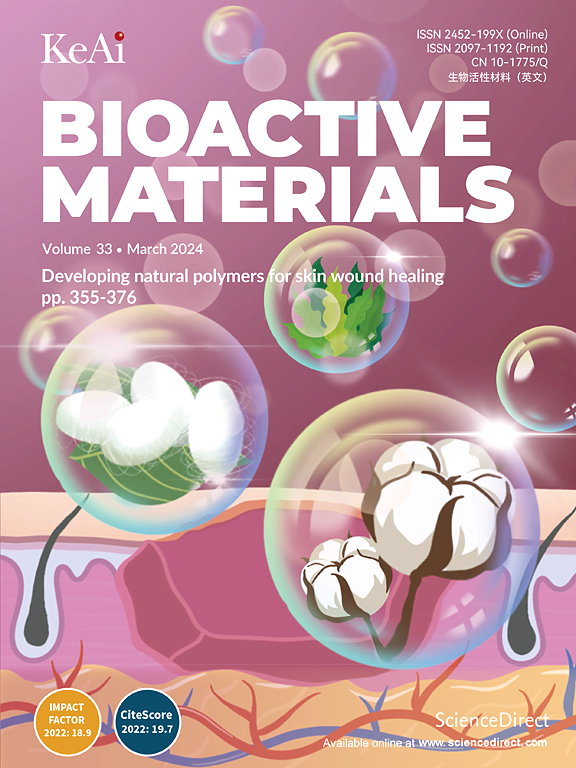Highly tough and conformal silk-based adhesive patches for sutureless repair of gastrointestinal and peripheral nerve defects
IF 18
1区 医学
Q1 ENGINEERING, BIOMEDICAL
引用次数: 0
Abstract
The use of tissue adhesive patches provides a promising therapeutic approach for sutureless repair of soft tissue injuries. However, existing tissue adhesive patches are confronted with serious challenges for clinical applications in the soft tissue environments with biological fluids and dynamic movements. Either their mechanical toughness does not match that of soft tissues, or they fail to establish effective interfacial bonding with tissues in wet conditions. The imbalance between the mechanical cohesion and interfacial adhesion of existing tissue adhesive patches severely restricts their conformal integration with wet surfaces of soft tissues in dynamic biological environments, leading to adhesion failure in clinical applications. Here, this study reports the design, fabrication, and preclinical therapeutic performance of a dual-layer silk-based adhesive patch (named SF patch) that quickly and conformally adheres to various soft tissues regardless of surrounding biological environments. The intimate microscopic structural connection between the highly tough hydrogel matrix layer and thin bioadhesive layer contributes to high mechanical cohesion and robust interfacial adhesion properties of the SF patch, thereby enabling sufficient integration with wet surfaces of soft tissues to withstand the interference of dynamic tissue movements. Ex vivo porcine and in vivo rat models validate its therapeutic efficacy for sutureless sealing and repair of gastrointestinal defects and peripheral nerve injuries. This SF patch is potentially valuable for clinical applications towards internal soft-tissue repair and functional reconstruction.

高韧性和适形丝基黏附补片用于胃肠道和周围神经缺损的无缝合线修复
使用组织粘接贴片为无缝线修复软组织损伤提供了一种很有前途的治疗方法。然而,现有的组织粘接贴片在具有生物流体和动态运动的软组织环境下的临床应用面临着严峻的挑战。要么是它们的机械韧性与软组织不匹配,要么是它们在潮湿条件下无法与组织建立有效的界面结合。现有组织粘接贴片的机械粘接与界面粘接之间的不平衡严重限制了其在动态生物环境中与软组织湿表面的适形结合,导致临床应用中的粘接失败。在这里,本研究报告了一种双层丝基贴片(命名为SF贴片)的设计、制造和临床前治疗性能,该贴片可以快速和适形地粘附在各种软组织上,而不受周围生物环境的影响。高韧性的水凝胶基质层和薄的生物胶粘剂层之间紧密的微观结构连接,使得SF贴片具有高的机械凝聚力和强大的界面粘附性能,从而能够与软组织湿表面充分结合,抵御组织动态运动的干扰。猪离体和大鼠离体模型验证了其对胃肠道缺损和周围神经损伤的无缝合线缝合和修复的疗效。该贴片在内部软组织修复和功能重建方面具有潜在的临床应用价值。
本文章由计算机程序翻译,如有差异,请以英文原文为准。
求助全文
约1分钟内获得全文
求助全文
来源期刊

Bioactive Materials
Biochemistry, Genetics and Molecular Biology-Biotechnology
CiteScore
28.00
自引率
6.30%
发文量
436
审稿时长
20 days
期刊介绍:
Bioactive Materials is a peer-reviewed research publication that focuses on advancements in bioactive materials. The journal accepts research papers, reviews, and rapid communications in the field of next-generation biomaterials that interact with cells, tissues, and organs in various living organisms.
The primary goal of Bioactive Materials is to promote the science and engineering of biomaterials that exhibit adaptiveness to the biological environment. These materials are specifically designed to stimulate or direct appropriate cell and tissue responses or regulate interactions with microorganisms.
The journal covers a wide range of bioactive materials, including those that are engineered or designed in terms of their physical form (e.g. particulate, fiber), topology (e.g. porosity, surface roughness), or dimensions (ranging from macro to nano-scales). Contributions are sought from the following categories of bioactive materials:
Bioactive metals and alloys
Bioactive inorganics: ceramics, glasses, and carbon-based materials
Bioactive polymers and gels
Bioactive materials derived from natural sources
Bioactive composites
These materials find applications in human and veterinary medicine, such as implants, tissue engineering scaffolds, cell/drug/gene carriers, as well as imaging and sensing devices.
 求助内容:
求助内容: 应助结果提醒方式:
应助结果提醒方式:


